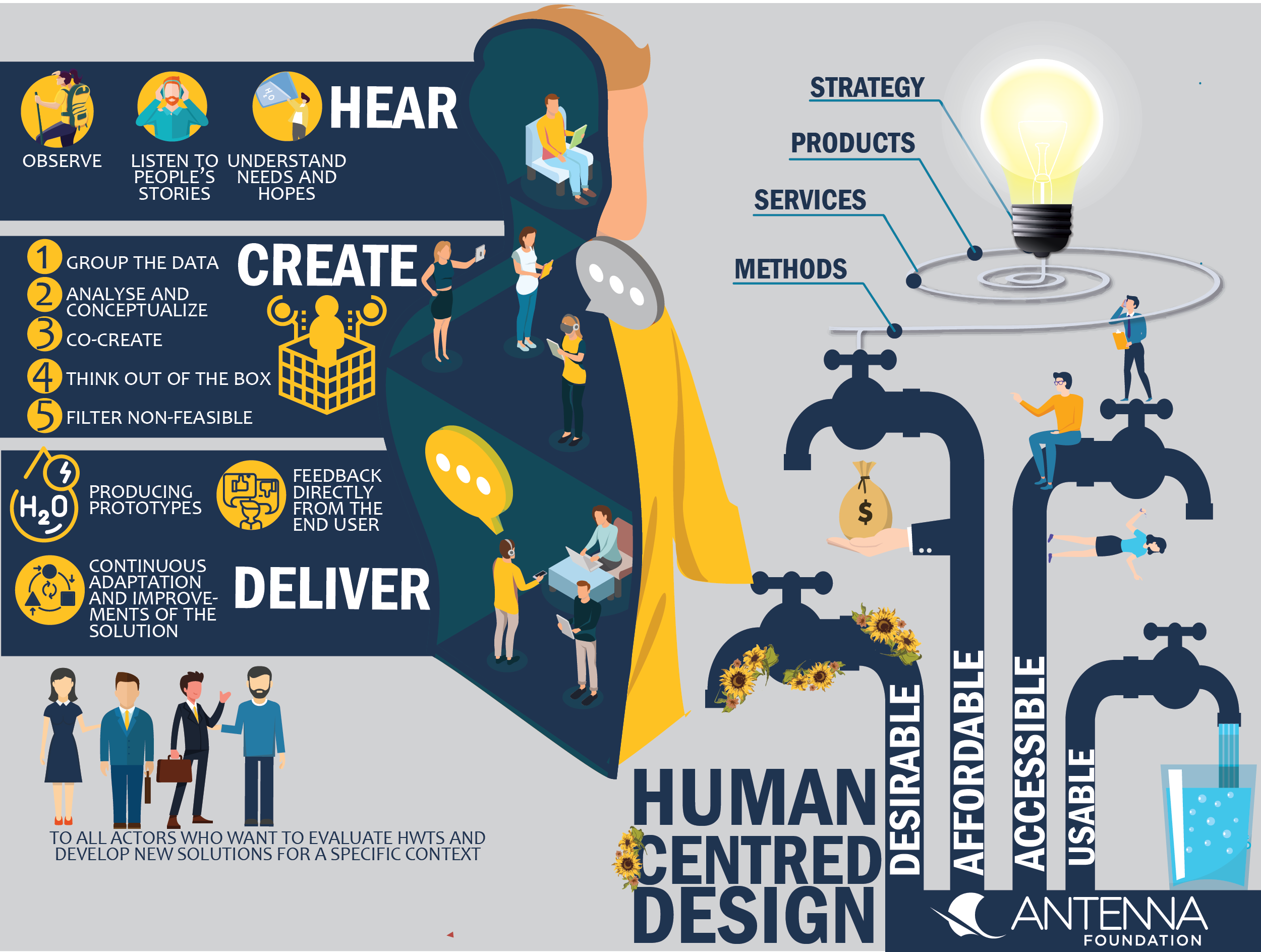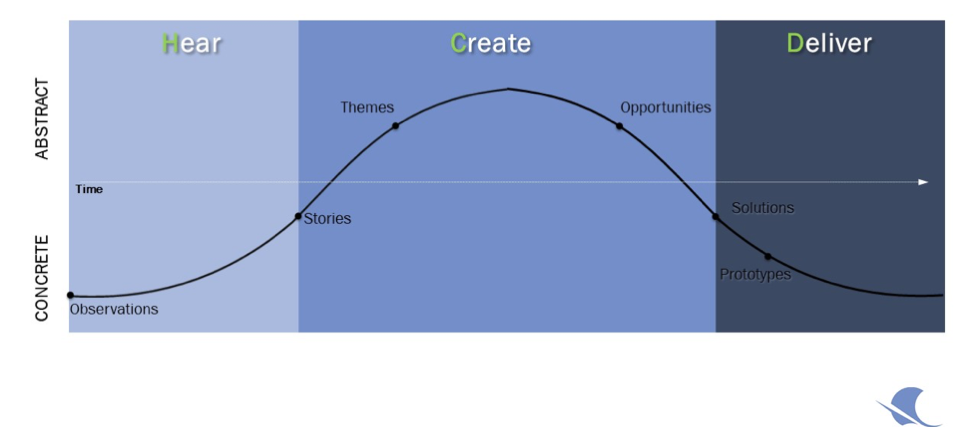
Human centred design (HCD) is an innovation methodology to develop appropriate and innovative ideas for solving problems. The HCD approach engages with end users to gain insight into their dreams, opportunities, and constraints without making any assumption about potential solutions. Those insights are then used through an iterative design process, to identify market-based solutions that maximise the likelihood of adaptation, scalability, viability, and desirability to serve particularly BoP customers through its holistic co-creation process. (IDEO, 2017b).
This factsheet introduces the HCD methodology and provides assistance to enterprises and NGOs to come up with new tailor-made solutions to suit customers’ real needs and are viable.
The case study about iDE Ghana and the implementation of a human centred design study reveals practical insights, lessons learned and observations o practical human centred design research in practice.

Human centred design is a practical, repeatable approach for developing innovative solutions by applying a design-oriented perspective. The solutions created with this methodology can include innovations of products, services, methods, and strategy among others. It is a creative process for problem solving that starts with people and creates tailored solutions that meet their individual needs. By looking at people’s needs and incorporating their point of view, one will be able to develop solutions that people will embrace, support and adopt in their daily lives. It’s a process both of thinking and doing that combines inspiration, ideation and implementation, or as the abbreviation HCD suggests: Hear – Create – Deliver shown in the graph above (adapted from IDEO 2017a).
The process of “Hearing” encompasses learning from the ground. Human centred designers try to understand the people’s problems, needs and hopes. Therefore listening to peoples’ and other stakeholders’ stories is crucial of this phase. This is usually done by qualitative research to observe the environment you are intending to design a solution for.
The “Create” phase is the process of collecting and structuring the gathered data. The data is analysed and subsequently conceptualised. In practice this means to gather in a group to structure the gathered information from the hearing phase and to come up with a lot of ideas associated with the identified core challenge. The designing group should be composed of people encountering the specific problem and people from outside. Within this co-creation process there should be no limitations - think out of the box and consider ideas that might not look like practical ones at first. For this phase of the process a variety of methodologies exists for idea generation. During an evaluation process following this idea gathering, you remove the non-feasible ideas and improve the ones identified as practical towards a solution.
During the “Deliver” phase you finalise a tangible product by producing prototypes of the identified solution(s). This allows you to have a tangible product or service to be tested and improved on the ground with the people for and with whom the solutions were designed. This co-creation allows getting a feedback directly from the end user and continuous adaptation and improvements of the solution. In parallel you should also think about creating partnerships, developing your business model and think about scaling your product in feasible contexts.
There are often interesting products or specific solutions to serve customers, but they fail reaching scale. The problems are manifold and include too high market retail prices due to too high production costs, inconvenient size, wrong product positioning and product perception, amongst others. Generally speaking: If users perceive a solution not to be desirable, affordable, accessible, and usable, it will fail in the market, especially for safe water technologies (DIJKSTERHUIS 2016). To mitigate the probability of failure, the human centred design methodology focusses on developing solutions for specific problems together with the end-consumer in a co-creation process. By finding a solution together with the user, be it either a new product or service or finding a suitable solution among existing ones, the acceptability and impact of it will be increased (IDEO 2017a).
This factsheet targets social entrepreneurs, NGOs, and all actors interested in evaluating existing household water treatment solutions (HWTS) and developing new solutions for a specific context. With the implementation of HCD-methodology, new ideas can be developed and incorporated in business models or developed to diversify the existing market-based approaches for safe water provision. This will allow having unique and innovative offers with increased acceptability. The cost of such a study is however relatively expensive. Because NGOs, public funders, or chambers of commerce might be interested in better knowing the market opportunities, they could possibly cover (part) of this cost (see blended finance).
Subscribe here to the new Sanitation and Water Entrepreneurship Pact (SWEP) newsletter. SWEP is a network of organizations joining hands to help entrepreneurs design and develop lasting water and sanitation businesses.
Enterprises can create and validate solutions with which they are able to make decisions on how to enter and create HWTS markets. In order to come up with innovative and feasible tailor-made solutions, different methods can be applied to hear, create, prototype and implement. A broad catalogue of different methods can be found here. Specific methodologies are outlined in the case study also.
Applying these different methodologies while building on existing HWTS solutions (for more information see kiosk and HWTS models) will enable you to create sustainable approaches to meeting people’s safe water needs. User needs are explored, solutions developed and finalized ideas validated.
A human-centered approach to design for development
What is human-centred design?
New product failure: Five potential sources discussed
DESIGNKIT – What is human-centred design?
Tools – Resources that Unlock the Power of Creativity
IDE WASH Ghana: Rural Sanitation Market Assessment in Northern Ghana
Why Human Centred Design Matters
Why Human-Centred Design Matters
The Field Guide to Human-Centred Design
Part of the IDEO mission is to spread human-centred design to social sector practitioners around the world. The Field Guide to Human-Centred Design reveals our process with the key mindsets that underpin how and why we think about design for the social sector, 57 clear-to-use design methods for new and experienced practitioners, and from-the-field case studies of human-centred design in action.
Licence (CC BY-NC-ND 3.0)
IDEO.org (2015): The Field Guide to Human-Centred Design. Canada: URL [Accessed: 23.07.2018] PDFDesign Thinking as Strategy for Innovation
Introduction to design thinking as method to creatively solve problems and come up with ideas for improving products and service delivery.
NAIMAN, L. (2016): Design Thinking as Strategy for Innovation. Vancouver: Creativity at Work URL [Accessed: 23.07.2018]Eight Practical Steps to Design for the Market
This blog post provides insights on how to develop radically innovative products and services for the poorest people around the globe. It provides additionally eight steps to help designing a branding and marketing strategy and a last mile supply chain that will put a product in the hands of a million or more customers.
POLAK, P. (2016): Eight Practical Steps to Design for the Market. URL [Accessed: 23.07.2018]Design Thinking for Social Innovation
The article introduces design thinking as concept and provides case studies on how the design methodology has been applied in practice.
BROWN, T. and WYATT, J. (2010): Design Thinking for Social Innovation. URL [Accessed: 23.07.2018]
